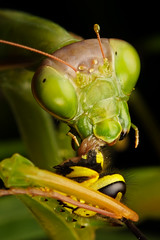Sorry folks -not one of my "warm and fuzzy" insect macro shots. But it's rare that I even see a mantis around here, and even rarer still to find one feeding, so when I spotted this huge female eating a wasp I had to photograph the action.
The hardest part of shooting a predator / prey scene is getting both of the creature's eyes in the plane of acceptable focus. We are predators, and we gauge the intent of other beings by looking at their eyes -it's just instinct. The funny thing is that if the eyes are in focus the rest of the shot can be completely out of focus and the viewer won't really care. But if the entire image is in focus, but the eyes are out, then the entire image will seem out of focus. With two "subjects", the mantis and its dinner, the eyes have to be in focus on both of them.
For this shot I wanted a tight composition -the mantis is in some weeds and there is a lot of junk behind her. The lower the magnification the greater the chance that the flash is going to illuminate something in the background and I hate spending any amount of time in post cloning out junk that I shouldn't have shot in the first place. I also wanted you, the viewer, with your attention right on the action. So I kept the magnification at around 2x but framed the shot as a vertical image -shot with the camera held horizontally because it's easier for me than holding the rig vertically. All I had to do was turn the image 90 degrees in post.
Since I was almost laying on my side, and I didn't move the flash heads, the lighting was very direct and moody. I frequently shoot with my flash heads at the 11 O'clock and 2 O'clock position (relative to me) and leave them there no matter what angle I have on the subject. The end result is lighting that doesn't look the same in every shot, and if an image comes out really well it's easy enough to just look at the specular highlights to tell where my flash heads were positioned. Recreating the same effect later, for another scene, is simple. One of the things that's really improved my lighting is learning how to reverse engineer the light in any image so I can see what works, what doesn't, and how to create the light that I want. The light in this shot is no accident -I knew what it was going to look like before I pressed the shutter. Like everything else it's easy to do with a little practice...


2 comments:
Can you explain "reverse engineering" the lighting?
thanks--ted
Take a look at the specular highlights Ted (the areas where you see the strongest reflections from the flash) and try to figure out where the flash was positioned (angle), the distance (rough guess), and the number of light sources. Also if there is some detail in the background how was it lit -flash or natural light? Me thinks this might be a good future post...
Post a Comment